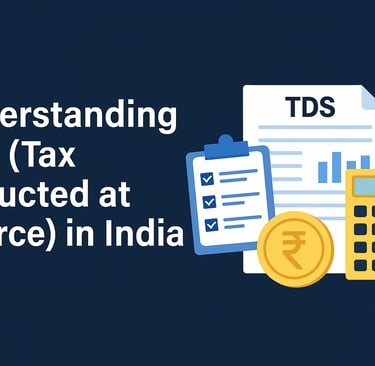TDS in India 2025 – Complete Guide to Tax Deducted at Source
4/10/20254 min read


Understanding TDS (Tax Deducted at Source) in India – 2025 Complete Guide for Individuals and Businesses
Tax Deducted at Source, widely known as TDS, is a critical mechanism in India’s tax administration framework. It is a method by which income tax is collected at the source of income generation. Whether you are a salaried individual, a freelancer, a property owner, or a business entity, TDS affects you directly. Understanding how TDS works, how it is calculated, and how it is managed can ensure smooth compliance, accurate tax planning, and hassle-free refunds during the annual return filing process.
In this detailed 2025 guide, we explore what TDS is, recent changes in TDS rates and rules, sector-specific implications, and strategies to manage it efficiently as an Indian taxpayer.
What is TDS?
Tax Deducted at Source (TDS) is a system introduced by the Income Tax Department where tax is deducted from certain payments at the time they are made. This system is applicable to a wide range of transactions including salaries, interest payments, rent, commissions, professional fees, and property purchases.
The objective behind this system is twofold. First, it helps in the regular collection of taxes for the government. Second, it prevents tax evasion by collecting tax at the time the income is earned, rather than waiting until the end of the financial year.
Why is TDS Important in 2025?
As the Indian economy continues to digitize and expand, real-time compliance with tax obligations has become increasingly important. In 2025, the government has introduced further integrations between TDS systems and digital platforms such as the Annual Information Statement (AIS), PAN-Aadhaar linkage, and Form 26AS.
Moreover, with increased scrutiny on high-value transactions and digital incomes (including cryptocurrency gains), accurate TDS deduction has become more than just a legal requirement—it is essential to avoid penalties, interest, and notices from the Income Tax Department.
Latest TDS Rates and Applicability in 2025
The TDS deduction rate depends on the nature of the payment. Here are some key scenarios:
Salary (Section 192): TDS is deducted as per the applicable income tax slab rates.
Interest from bank deposits (Section 194A): 10% if interest exceeds ₹40,000 (₹50,000 for senior citizens).
Dividend income (Section 194): 10% TDS on dividend income above ₹5,000.
Property transactions (Section 194IA): 1% TDS on sale of immovable property worth over ₹50 lakhs.
Rent payment by individuals (Section 194IB): 5% if rent exceeds ₹50,000/month.
Professional fees (Section 194J): 10% for services exceeding ₹30,000/year.
Crypto gains (Section 194S): 1% TDS continues on transactions above ₹10,000.
Note: If the deductee fails to provide a PAN or has not linked it with Aadhaar, TDS may be deducted at a higher rate of 20%.
How Does TDS Work?
TDS is deducted by the payer (deductor) and deposited to the government on behalf of the recipient (deductee). The deductee receives the net amount after TDS and can claim credit when filing the Income Tax Return (ITR). All such deductions are reflected in Form 26AS and AIS.
Let’s consider an example: If a freelancer earns ₹1,00,000 for a project, the client deducts ₹10,000 (10% TDS under Section 194J) and pays ₹90,000. The ₹10,000 deducted is shown in the freelancer’s Form 26AS and can be adjusted during ITR filing.
Managing TDS in the Digital Era
India’s tax system is becoming increasingly transparent. Today, a mismatch between income declarations and TDS entries is easily detected through digital analytics. Therefore, it is vital to reconcile the following:
Form 26AS: Contains all TDS entries linked to your PAN.
AIS (Annual Information Statement): Includes additional financial data such as investments, foreign remittances, and high-value purchases.
Form 16/16A: Certificates issued by the deductor for salary and non-salary income.
TDS for Freelancers, Professionals, and Consultants
In 2025, freelancers and consultants face growing TDS obligations. Any individual earning professional income over ₹30,000 from a single payer must receive a payment after 10% TDS. It is important to retain all Form 16A certificates and reconcile them with Form 26AS before filing taxes.
Furthermore, if your total income falls below the taxable threshold, you can submit Form 15G or 15H to avoid unnecessary TDS deductions.
TDS on Property and Rental Income
Property-related transactions are increasingly under TDS scrutiny:
Buyers of property worth more than ₹50 lakhs must deduct 1% TDS and deposit it using Form 26QB.
Rent payments above ₹50,000/month from individuals are subject to 5% TDS under Section 194IB.
Non-filing of TDS on rent or property can result in interest and penalties.
Tips to Avoid TDS Errors
Always check your PAN-Aadhaar linkage to prevent higher TDS rates.
Review Form 26AS quarterly to confirm accurate entries.
Use TDS calculators and filing software to compute applicable deductions.
File TDS returns (Form 24Q, 26Q, 27EQ) on time if you are a deductor.
Ensure you maintain updated records of all TDS certificates and challans.
Final Thoughts
TDS may appear as a minor deduction on your payslip or invoices, but it is an essential component of India’s taxation system. As digital compliance becomes more real-time and error-sensitive, staying on top of TDS regulations can prevent future liabilities and ease the tax filing process.
For individuals, proper knowledge of TDS helps in claiming accurate refunds and planning investments. For businesses, timely deduction and deposit of TDS can save thousands in penalties and ensure regulatory compliance.
At One Solution, we simplify tax planning by offering complete tracking, TDS reconciliation, advisory, and filing solutions—making it easier for individuals and businesses to stay compliant and financially healthy in 2025.
About One Solution
Quick Links
Contact Info
One Solution — Your trusted partner for financial success.
📍 F17, Grand Plaza, Paltan Bazar
Guwahati, Kamrup (M), Assam
India, Pin: 781008
📞 9650072280
© 2025 One Solution. All Rights Reserved.
